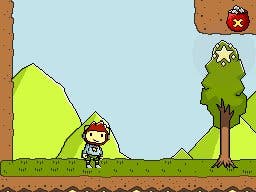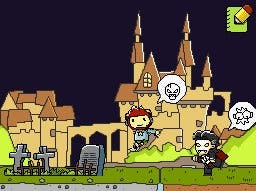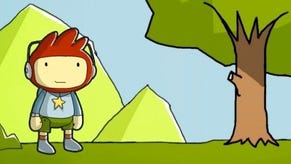Scribblenauts
Word up.
One of the most dependable joys of writing about videogames is hearing the implausible claims made by developers regarding their latest titles: "hundreds of separate light sources", "the frame rate will be locked at 1600fps", "it's basically interactive storytelling", "this time, you'll really care about Falco Lombardi". But Scribblenauts tops them all. This mild-mannered DS game has a premise so staggeringly unlikely that when you first hear it you may find yourself trilling with dainty laughter at the very thought of somebody trying to pull it off. "Yeah," sighs lead designer Matt Cox, the very somebody in question. "We tend to get that reaction a lot."
The premise is this: Scribblenauts is a platforming puzzle game, in which Maxwell, a chirpy cartoon boy who appears to have had a be-quiffed television set jammed over his head, has to collect Starites by completing a variety of challenges - dislodging one from a high tree, for example, or winning one as an award for helping an old man pass an eye test. "WarioWare is the best analogy for the way the game plays," says Cox. "It's different kinds of situations, one after the other, with a wide range of challenges." And the implausible bit? To beat each level, the player summons objects to help Maxwell, by writing their name on the bottom screen.
Yes: any object.

Well, any object within reason. Proper nouns and anything grotty have been ruled out, but these are just about the only limits to what you can conjure up. The game's trailer, which features that Starite stuck in a tree, offers three different examples of the system at work. In the first, a ladder is summoned, and Maxwell simply climbs it to get his prize. In the second version, he calls up a football, and kicks it to dislodge the Starite. The final playthrough sees him conjuring up a beaver to gnaw through the trunk. Presumably, you could also blow the tree to pieces with nuclear weapons, ram into it with a New York City taxi cab, or even dislodge it with a passing swoop of a Sopwith Camel.
As the beaver example suggests, everything summoned into the world will act appropriately. "A lion behaves like a lion, and a frying pan behaves like a frying pan," says Cox. "It's all realistic, and it has to be: it's not like you write 'oven' and you get a magic oven that you can fly around on." There's another dream of ours cruelly dashed.
Unlikely as all this seems, 5th Cell, the developer of Scribblenauts, does actually have previous form with this kind of game. Drawn to Life, its breakout DS title, featured a similar user-generated premise, albeit one a lot more contained, as players sketched in their own artwork for the game's main character and much of the environment, before embarking on a simple platforming quest.
But Scribblenauts is a lot more ambitious, and the team has spent much of the last year trying to make the concept work. That's no easy task, since every word in the game's dictionary not only needs a corresponding graphic, but a set of believable attributes and behaviours as well.

To help them with this frankly insane task, the developers have created a database called Objectnaut. "The way it works is we've started with the qualities rather than the objects," explains Cox. "We've started with categories and sub-categories, like flammable, electrical, heavy, organic, and then we place each object within this framework. That means an object already inherits loads of qualities as soon as it's put into the system: we don't have to say fire would burn this wooden ladder or this boat. We simply say fire would burn everything that's flammable, and anything made of wood will already be marked up in the database as flammable. And when someone slots in a bird, we know from the start that it's organic and it flies, and it has AI properties and that sort of stuff, right from the word go. We don't have to go through thousands of objects one by one, assigning properties." So with Objectnaut in place, it's just a case of filling up the database. With every single object players are likely to think of. Simple.




